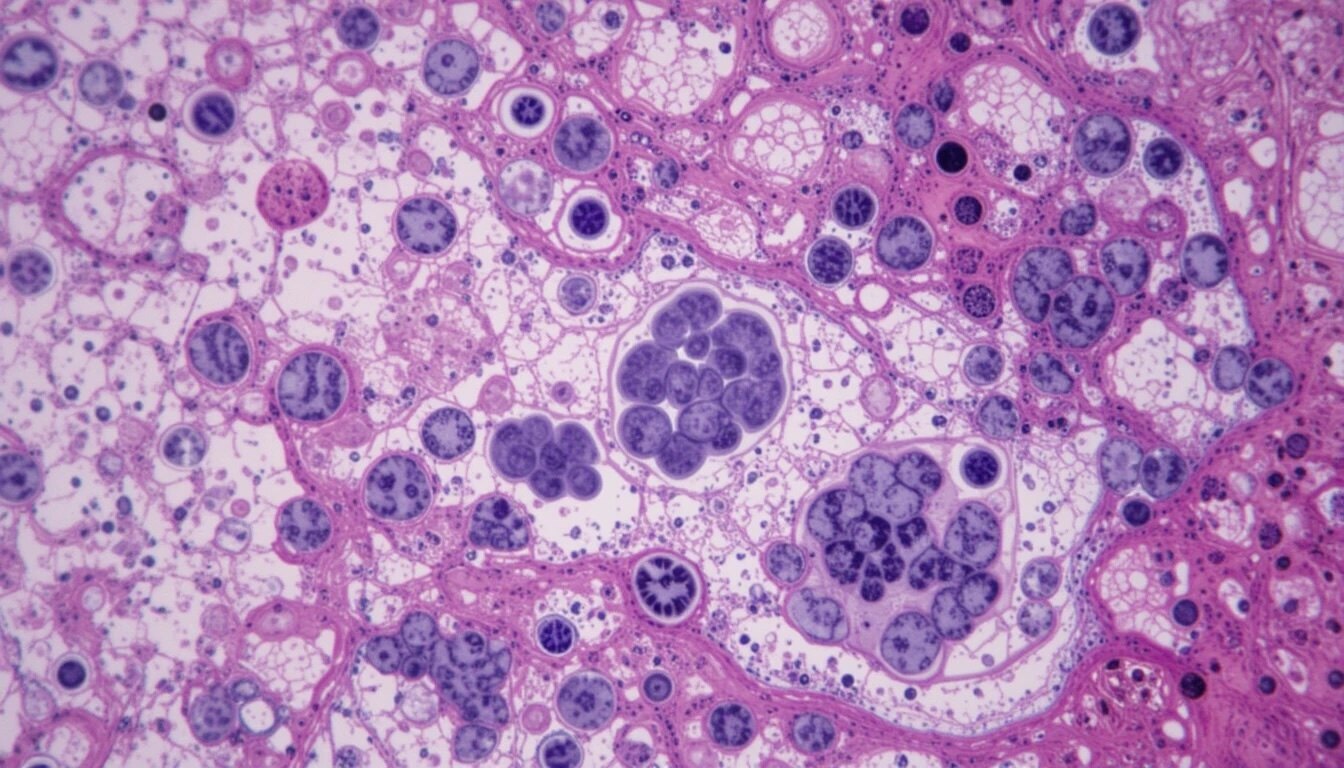
What exactly is an Aschoff body? This term might sound like something out of a sci-fi novel, but it's actually a key player in the world of medicine. An Aschoff body is a collection of cells found in the heart tissue of individuals with rheumatic fever. These tiny structures are named after the German pathologist Ludwig Aschoff, who first described them in the early 20th century. Aschoff bodies are significant because they indicate inflammation and damage in the heart, which can lead to serious complications if not treated. Understanding these bodies helps doctors diagnose and manage rheumatic fever more effectively. Ready to dive into 30 fascinating facts about Aschoff bodies? Let's get started!
Key Takeaways:
- Aschoff bodies, named after a German pathologist, are heart lesions found in rheumatic fever patients. They can cause heart inflammation and damage, leading to chronic conditions like congestive heart failure.
- Detecting Aschoff bodies is crucial for diagnosing and managing rheumatic fever. Early detection through biopsies, autopsies, and echocardiograms can help prevent long-term heart damage.
What is an Aschoff Body?
An Aschoff body is a type of lesion found in the heart tissue of individuals with rheumatic fever. These nodules are a hallmark of the disease and can provide crucial insights into its progression.
- Aschoff bodies are named after German pathologist Ludwig Aschoff, who first described them in 1904.
- They are typically found in the myocardium, the muscular tissue of the heart.
- These lesions are composed of a central area of necrosis surrounded by immune cells.
- Aschoff bodies are most commonly associated with rheumatic fever, a complication of untreated strep throat.
- They can cause inflammation and damage to the heart valves, leading to rheumatic heart disease.
Composition of Aschoff Bodies
Understanding the makeup of Aschoff bodies helps in diagnosing and treating rheumatic fever.
- The central area of an Aschoff body consists of fibrinoid necrosis, a type of tissue death.
- Surrounding this necrotic core are macrophages, a type of white blood cell.
- These macrophages are often referred to as Anitschkow cells, named after Russian pathologist Nikolai Anitschkow.
- Anitschkow cells have a distinctive appearance, often described as "caterpillar cells" due to their wavy chromatin.
- Other immune cells, such as lymphocytes and plasma cells, also surround the necrotic core.
Detection and Diagnosis
Identifying Aschoff bodies is crucial for diagnosing rheumatic fever and preventing further complications.
- Aschoff bodies can be detected through a biopsy of heart tissue.
- They are often found during autopsies of individuals who had rheumatic fever.
- Echocardiograms can sometimes reveal the presence of these lesions.
- Blood tests showing elevated levels of inflammatory markers may suggest the presence of Aschoff bodies.
- Early detection can help in managing symptoms and preventing long-term damage to the heart.
Impact on the Heart
The presence of Aschoff bodies can significantly affect heart function and overall health.
- Aschoff bodies can lead to myocarditis, an inflammation of the heart muscle.
- This inflammation can weaken the heart, reducing its ability to pump blood effectively.
- Over time, the damage can lead to chronic heart conditions such as congestive heart failure.
- Rheumatic heart disease, caused by Aschoff bodies, is a leading cause of heart valve damage.
- Surgical intervention may be required to repair or replace damaged heart valves.
Treatment and Management
Managing rheumatic fever and its complications involves addressing the underlying causes and symptoms.
- Antibiotics are used to treat the initial strep throat infection and prevent rheumatic fever.
- Anti-inflammatory medications can help reduce the inflammation caused by Aschoff bodies.
- Long-term antibiotic prophylaxis may be recommended to prevent recurrent infections.
- Regular monitoring of heart function is essential for individuals with a history of rheumatic fever.
- Lifestyle changes, such as a healthy diet and regular exercise, can support heart health.
Historical and Global Context
Rheumatic fever and Aschoff bodies have a significant impact on global health, particularly in developing countries.
- Rheumatic fever was once a leading cause of death in children before the advent of antibiotics.
- It remains a major health concern in developing countries with limited access to healthcare.
- Public health initiatives aim to reduce the incidence of rheumatic fever through improved sanitation and access to medical care.
- Research continues to explore new treatments and preventive measures for rheumatic fever and its complications.
- Awareness and education about the importance of treating strep throat can help prevent the formation of Aschoff bodies and subsequent heart damage.
Final Thoughts on Aschoff Bodies
Aschoff bodies, those tiny nodules found in the hearts of people with rheumatic fever, play a crucial role in understanding this disease. Named after Ludwig Aschoff, these structures help doctors diagnose and treat rheumatic fever more effectively. They form due to the body's immune response to a strep infection, causing inflammation in the heart tissues. Recognizing the presence of Aschoff bodies can lead to early intervention, potentially preventing severe complications like heart valve damage.
Understanding these nodules isn't just for medical professionals; it benefits anyone interested in how our bodies fight infections. Knowing about Aschoff bodies highlights the importance of timely treatment for strep throat to avoid long-term heart issues. Stay informed, take care of your health, and remember that even the smallest details in our bodies can have significant impacts.
Frequently Asked Questions
Was this page helpful?
Our commitment to delivering trustworthy and engaging content is at the heart of what we do. Each fact on our site is contributed by real users like you, bringing a wealth of diverse insights and information. To ensure the highest standards of accuracy and reliability, our dedicated editors meticulously review each submission. This process guarantees that the facts we share are not only fascinating but also credible. Trust in our commitment to quality and authenticity as you explore and learn with us.
